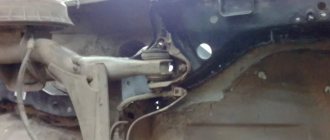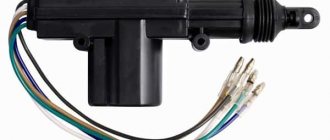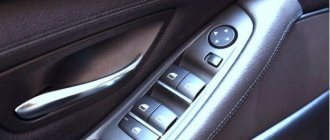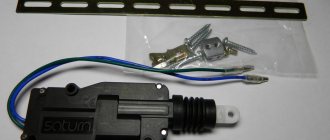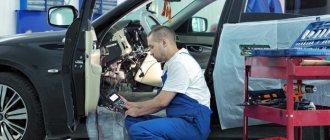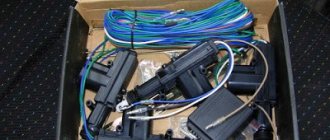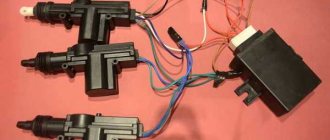In order to protect your car from theft, you can equip it with a device such as a central electronic lock. To do this, it is not at all necessary to contact a service or specialized workshop, because in fact, its installation is much simpler than it seems at first glance. In today's article we will talk about how to install central locking on a VAZ 2114 and how to avoid possible mistakes.
Alarm system with central locking VAZ 2114
Introduction
I went online to search for information on how people connect these Chinese units to a VAZ and came to the conclusion that everyone installs such units in a terribly artisanal way, removing half of the wiring, adding some of their own, and in the end, all this does not “successfully” work. Among the makeshift connection instructions, I came across the only normal article by Soliderus, who installed a similar control unit on his Chrysler; his article helped me a lot. But since we have a harsh domestic auto industry, we had to invent our own connection diagram, but first things first.
Please read this entire article first before disassembling the machine; you may not have any parts on hand or may be missing some of the original wiring.
Used kit
The kit is small and is pictured in full below:
Used kit
The kit also includes instructions in English:
Instructions - description of the control unit
Connection diagrams
Theory
Before starting the installation, I want to warn you about the characteristics of my particular VAZ 2114 car (2006 model year, “Lux” equipment, the wiring under the dashboard is numbered as “VAZ 2115-...”), since I myself, from personal experience, have seen “four” and “tags” of the same year of manufacture, the same configuration, but with completely different wiring (I assume that this was due to different supplies of wiring to the conveyor).
After looking at the information on the Internet, I came to the conclusion that the overwhelming number of people install the control unit according to the wrong diagram “D”, from the instructions, which will not fit the Samar family (VAZ 2108/09/99/13/14/15) , since the opening and closing of doors (or rather, the supply of a signal to the BUDU (Door Lock Control Unit)) in Samara is controlled by a “minus”, and according to the “D” scheme, control occurs by supplying a “plus” to the BUDU. As I found out, this scheme only works when the standard BUDU is removed and the BU works every other time and only one button on the control key works. In my case, when connecting circuit “D” (I tried to connect it together with the BUBD), I burned several fuses and started looking for another connection method.
The scheme we need and works is scheme “C”
Scheme C
According to this scheme, our control unit will send a “minus” signal to the BUDU and everything will work normally, without removing the BUDU itself.
Installation
To begin with, I determined which wires in the control unit block I needed and which I did not. I didn’t need: - green wire - window closer; — blue wire — trunk opening; — pink wire — siren (there was a siren, but I just didn’t want to install it); Also, orange and orange-black wires are not needed, since according to scheme “C” they are not needed.
We still have: - red - “plus” 12v to the battery; — black — “minus” 12v (I connected the minus to the body, since the control unit does not necessarily require a minus power supply from the battery); — yellow and yellow-black — connect to the negative (I connected them to the main negative and all 3 wires to the body); - 2 brown ones - they supply a plus to the alarm button (some people connect them to the dimensions); — white — it sends a minus for closing; - white-black - it sends a minus to the opening.
For clarity
Used block with signatures
The control unit was installed on self-tapping screws, on the lower plastic part of the panel (to the left of the steering wheel height adjustment lever, next to the hood opening handle), but you can install it as you wish.
Plus, I stuffed it into the cambric and passed it through the rubber of the headlight range control, making a small hole with an awl (I couldn’t find a more convenient place, without drilling, in the whole car):
Positive wire
Under the hood I connected the plus directly to the standard terminal, tightening the bolt to “10”:
Positive terminal
I started connecting the emergency lights. I read on the Internet that you need to disassemble the hazard warning button, solder something, short circuit something, and in general it turns out that this round button interferes with normal steering and everywhere they show how to redo it. In general, I did not find a complete pinout of the button; with the help of a general electrical diagram and the scientific “poke method” I found out that:
— blue-black wire — left turn; - blue wire - right turn
Hazard warning button block
I again stuffed the two brown wires into the casing and brought them to the emergency flasher button block, pulled out the blue-black and blue wires from the block, using a small awl and “someone’s mother,” and soldered the brown wires directly to the “mother” terminals, so how I didn’t want to cut off the factory terminals (you don’t need a lot of tin, because if there is a lot of it, the terminals won’t fit back into the block):
Emergency signal block with soldered brown wires BU
Removing the BUDU turned out to be not an easy task; it is located above the hood release handle, almost under the dashboard, in general in not the most convenient place.
I have installed BUBD 21093-6512010-03 NPO Itelma.
BUBD 21093-6512010-03 NPO Itelma
This BUBD was installed on all Samara II (VAZ 2113/14/15), I’m not sure about the Samar I (VAZ 2108/09/99), check whether the BUBD is the same on your car, because the pinout may be different. The wires we need in the BUBD block are: - brown - closing the doors; — blue — opening doors By analogy with the emergency gang, I soldered the wires to the terminals according to the diagram: — brown from the BUBD with white from the control unit; — blue from BUBD with white and black from BU
BUBD block with soldered wires from the control unit
Now the most interesting part is the driver's door.
We remove the door trim, remove the black “anthers” from the inside.
There are several options:
Option 1) You have a certain “microswitch” in the driver’s door, which, when you open the driver’s door with the key, sends a signal to the ECU and it opens the other doors (another name for such a switch is central locking, since without such a switch you would have to close each door separately). The driver's door motor is missing. There is also a block with two wires in the driver’s door: one is red, the other is yellow (the same blocks are 100% in the other 3 doors of the car) they supply power to the electric motor, which opens/closes the door lock.
Option 2) Everything is the same as in point 1, but the block with the red and yellow wires is missing (a very common situation, especially if the equipment is not “Lux”). In this case, you need to pull these wires from the ACU to the driver's door (the diagram of the door lock system will be below).
Option 3) You have/have had a non-standard alarm installed and now you have more wires in the driver's door than in the entire car. Here I can’t tell you anything, since I myself have not installed a non-standard alarm system in Samara, try to figure it out using a diagram of the door lock system.
Shown here is an unmodified VAZ 2114/15 (may be the same as the VAZ 2109/99):
Door lock system diagram
We have the first scenario, which means we must first remove the “microswitch”.
Microswitch
How to remove it is detailed here. Personally, I removed it with a Phillips “screwdriver attachment.”
Next, we need to buy a so-called “actuator” (an electric motor (also known as a gearmotor, also known as a door activator) with a contact group, that is, it will perform not only the role of an electric motor, but also the role of a microswitch at once). I didn’t “reinvent the wheel” and install some strange actuators with strange alarms, which are not sold in all auto parts, for which you need to drill holes in the door, I just bought a standard actuator under the number: 21093-6512110-01, he already has All the wires and necessary connectors are present, there is no need to solder or drill anything:
Actuator 21093-6512110-01
You can also install a regular 2-pin electric motor, with two wires 21093-6512210-01, which is installed in the passenger doors:
Electric motor 21093-6512210-01
But in this case, you will only be able to open the doors with the BU key; only the driver's door can be opened through the driver's lock (3 passenger doors will not open), because it does not have a built-in microswitch, like in the 21093-6512110-01 actuator, which gives a return signal on the BUBD (in fact, because of the built-in microswitch it is called an actuator, this is its main difference from a conventional electric motor).
You also need to buy a rod for the driver's door lock, I couldn't find one for sale, so I bought several repair kits for the door lock rods and several bushings for the door rods, in the end I got an almost original rod (I copied the length and bend from the rod for the front passenger's door lock), even with ability to adjust the length of the pull:
Homemade door lock rod
You also need to buy long screws to fix the actuator in the door. This is roughly what it looks like when assembled:
Door with actuator
Well, everything works, but in this state the car will close all doors only with the BU key, the actuator will strongly resist, if you open the driver's door with a regular key, it will open the door, but will immediately close it, because the CU will give the command to close the doors . This way the door can be opened a couple of times without any problems, in case of emergency.
And here we could finish the article... But then I thought about it and decided that I want to keep both the functionality of the control unit and, just in case, keep the standard functionality of the central lock (so that all doors can be opened with a key).
Without soldering, I added the 3-pin block so that I could interrupt the constant negative (black wire):
Rework
Now in one position of the switch, only the control unit works, in another position of the switch, only the central lock works, while nothing is bridged and everything works. I placed the switch together with the window lift buttons into the “stuff pocket” of the door.
I placed and connected a light bulb, which, attention, blinks. This LED is connected to a separate small red connector on the control unit; it blinks when the control unit is in the “closed” state.
Bulb
Bottom line
In this simple way, we installed the Chinese central locking control unit without cutting a single factory wire or drilling a single extra hole in the body.
PS - in 3 months of operation nothing burned, melted or exploded. The control unit does not discharge the battery, since it is not an alarm and it does not have a constant connection with the key fob; the only source of consumption is the light bulb. The BU key is triggered when it is relatively close to the car; the CU's antenna is not large and picks up the signal in different places at a distance of 5 to 20 meters.
Price: - BU: 900 rubles - Actuator: 390 rubles - Door rod repair kit: 108 rubles (2 sets) - Door rod bushing: 40 rubles (2 pcs.)
Theory
Before starting the installation, I want to warn you about the characteristics of my particular VAZ 2114 car (2006 model year, “Lux” equipment, the wiring under the dashboard is numbered as “VAZ 2115-...”), since I myself, from personal experience, have seen “four” and “tags” of the same year of manufacture, the same configuration, but with completely different wiring (I assume that this was due to different supplies of wiring to the conveyor).
After looking at the information on the Internet, I came to the conclusion that the overwhelming number of people install the control unit according to the wrong diagram “D”, from the instructions, which will not fit the Samar family (VAZ 2108/09/99/13/14/15) , since the opening and closing of doors (or rather, the supply of a signal to the BUDU (Door Lock Control Unit)) in Samara is controlled by a “minus”, and according to the “D” scheme, control occurs by supplying a “plus” to the BUDU. As I found out, this scheme only works when the standard BUDU is removed and the BU works every other time and only one button on the control key works. In my case, when connecting circuit “D” (I tried to connect it together with the BUBD), I burned several fuses and started looking for another connection method.
The scheme we need and works is scheme “C”
Scheme C
According to this scheme, our control unit will send a “minus” signal to the BUDU and everything will work normally, without removing the BUDU itself.
Design and malfunctions of the central locking VAZ 2114
A useful addition to the design of any vehicle is a central lock, which simultaneously with opening the driver's door allows you to control all the doors of the car. Unfortunately, the VAZ-2114 central lock sometimes starts
does not function correctly, this is manifested in the lack of response when turning the key in the lock or when pressing the control key on the remote control. Let's consider the main reasons causing the malfunction of this unit.
Diagnosis and care
In order for everything to work normally and without failures, this system must be promptly maintained and diagnosed. In fact, the car must be constantly monitored by the driver, otherwise some systems may fail while driving.
The main failure in the system is that after washing in winter, the locks freeze. In order to avoid this problem, you should ventilate the lock. Unfortunately, many car washes do this rarely or not at all. When the lock freezes, the driver simply will not be able to get into the car because the cylinders freeze and the key cannot be inserted or does not open the door.
It often happens that after washing the driver easily opened the car and drove home or to work, leaving the car on the street for some time, the moisture in the lock freezes, does not allow the larvae to move, and when the driver tries to open the door, the key simply cannot be inserted into the larva of the castle.
Freezing of larvae happens not only with central locking, but also on cars that do not have this system. On those cars where there is no central locking, everything is much simpler; all you have to do is pour hot water on the lock, the cylinders will begin to move and the car will open. The situation with the central locking is more complicated; here the rods freeze, blocking all the doors.
How does the VAZ-2114 central lock function and where is it located?
This unit is aggregated with a lock on the driver's door through a control element (electric drive), which, in addition to allowing you to open or close it, additionally generates signals sent to the VAZ-2114 central locking unit, where, after their analysis and processing, commands are generated for actuators of the remaining doors of the car.
When closing, the control unit rod closes the corresponding pairs of contacts, as a result of which voltage is supplied to the other drive modules, which drives them. When opening and closing, different contact pairs are closed.
The figure shows a simple diagram of the VAZ-2114 central locking:
Connecting the cz VAZ 2110 - photo, description on VAZ-2110.net
Connecting an alarm system to the central locking of a VAZ 2109 Do it yourself.
central locking circuit with alarm.
Central lock control button.
Central locking diagram for VAZ 2114.
Replacing the instrument panel illumination bulb of a VAZ 2114.
With this connection diagram.
Use a knife to make a hole in the door trim of a suitable size and install it.
Central lock Starlain A8 connection diagram - Photo hosting - national photo archive, ra.
Lada 2115 230 pearl.
Door lock system for VAZ 2115 Lada.
Lada 2110 Priora in an old body.
Central lock VAZ 2110.
When installing a central lock on a VAZ 2106, you can go in two ways.
Connection diagram for central locking VAZ 2109 - Installation of central locking.
If you need a wiring diagram for the VAZ ignition switch, you can easily find it.
Common node faults
Often the central locking of the VAZ-2114 is controlled incorrectly due to the fact that the contact pairs are closed with a delay. A common reason for this is a violation of the adjustment of the thrust located between the gearmotor and the lock button, or its jamming. Simply put, when the button is pressed, the position of the rod does not allow the contact pairs of the drive to be completely closed.
The door on the driver's side may be locked, while the others will remain open due to the fact that the contacts of the control unit are not fully closed. This malfunction is purely mechanical in nature, and to eliminate it, it is enough to adjust the rod or the free play of the button in case it gets stuck.
In addition, such a problem can be caused by a malfunction of the VAZ-2114 central locking relay. In this case, you will have to replace the failed element.
In the case when the VAZ-2114 central locking completely stops responding to commands given by the driver, it is worth moving on to checking the electrical part of this unit. It is possible that this behavior of the system is caused by a blown fuse. Note that it can fail not only in the event of a short circuit, but also from constant overloads caused by the heavy movement of the core, or a violation of the adjustment of the rods.
Quite often, the reason why the VAZ-2114 central lock does not work is a violation of the integrity of the electrical wiring supplying power to it. The wires in the driver's door of a vehicle almost always break because it opens and closes more often than others. You can determine the damaged section of the wire using a multimeter. Less often than not, the control unit fails. In this case, the entire system either completely stops working or performs its functions incorrectly.
To prevent module malfunctions, it is necessary to pay attention to the condition of the activator, since its contacts can oxidize or burn, causing malfunctions. Periodic cleaning will significantly extend the life of the module.
Other system failure options
The above problems are the main causes of damage. However, there is a more complex mechanism, the defect of which cannot be ignored.
It happens that with the manual activation method the central lock is not operational. In this particular case, most likely the VAZ 2114 central locking fuse is not working. Its condition depends on the ambient temperature. Due to hypothermia, malfunction occurs and it fails, as a result of which nothing happens. The central locking system does not respond to signal impulses. Another reason is high temperature, which causes a short circuit.
Fact: Often, central locking works intermittently in certain places. This is usually caused by electromagnetic interference.
Many problems are common to all models. First of all, these are problems with the key fob. Main faults 2:
- The battery is low;
- Synchronization is broken.
The failure of the battery can be determined by the rapid blinking of the LED. This effect is observed when pressing any key. If you get close to the car, you can open it for some time. But it is still recommended to immediately replace the battery when blinking occurs. To do this, disassemble the key fob and see which battery is installed here. Then they put the keychain back together. The store purchases a new battery and installs it.
How the central lock works
The central locking algorithm consists of sending an impulse to the VAZ 2114 central locking control unit, which analyzes the received signal and generates commands that control the door locks. They are either opened or locked.
General scheme of central locking
Elements that activate the central locking are connected to pin 30. If contact 87 closes, then the activator outputs will be affected by ground. When a certain relay 30 is activated, the contact will connect to the positive. Thus, the activator will receive power and the rod will begin to move. The control unit rod closes different pairs of signals depending on what action needs to be performed: closing or opening the doors.
Since the central locking activators are connected in parallel, all doors will either open or lock at the same time. Central locking can be pneumatic or electric. The first type of device includes a control panel, compressor and tubes. In an electric one, the main element is a motor, thanks to which the mechanisms are activated.
Possible malfunctions of the locking system
If there is no reaction when you turn the key in the lock or press a key on the remote control, this means that the central locking is not working.
All causes of central locking malfunction can be divided into two types:
- technical;
- related to climatic phenomena.
In the first case, breakdowns are possible due to incorrect installation or configuration of the locking system. Subject to natural wear and tear after long-term use. The service life directly depends on the quality of the device.
In the second case, the central locking system may fail under the influence of low temperatures and it may freeze. The lock may not work if water gets into the mechanism during rain or melting snow.
The central locking system may not work due to an incorrectly installed or faulty alarm system. In this case, you should diagnose the locking system. The control activator is installed in the driver's door. As soon as the drive is activated, signals are sent through the appropriate channels to the remaining activators, according to which the required action is performed. Therefore, you should check the operation of the lock using the key and the button on the key fob.
If the doors sometimes close, sometimes they don’t, then the reason may be in the control circuit or a violation of the integrity of the electrical circuit of the car alarm. The reason why the central locking system fails to operate may be insufficient battery charge or a blown fuse. Depending on the circuit being used, there may be multiple fuses. They all need to be checked and faulty ones replaced.
The fuse can burn out as soon as it is installed, due to a short circuit or overload, for example, when controlling the central locking with a key fob, and not manually. In warm weather, the reason is a short circuit, which is possible due to poor contacts or an open circuit. The cause of the breakdown may be a malfunction of the central locking control unit.
You can check the operation of the unit using a multimeter by checking the power supply to the activators. Current is supplied to the contacts of the unit by unlocking and locking the driver's door. If the control unit is broken, it needs to be replaced.
Signs of trouble
Why does the VAZ 2114 heater fan not work
? The occurrence of any malfunction in the operation of the central car lock instantly manifests itself in the form of a violation of its functionality. In this case, the signs or symptoms of a breakdown correspond to what exactly happened to the system. Therefore, problems can be identified by the following nuances:
- it is not possible to open the car using the key fob;
- opening does not work when using the key;
- the key fob does not lock the car;
- the key or button does not work when closing the door;
- one of the doors does not open or does not open;
- The central locking is triggered, closes everything, but immediately opens without a corresponding command from the driver;
- locking and unlocking work spontaneously.
We can say that malfunctions manifest themselves in the form of incorrect operation of the system. The central locking system is a complex device that consists of a large number of components and control units. This is a whole network of electrical wires, which sometimes covers the entire car. Given the complexity of the system, consideration should be given to who will carry out the repairs. It is often recommended to entrust this to specialists. At the same time, every motorist has the right and opportunity to know what malfunctions occur with the central locking, what is their cause and how they can be dealt with. Whether to repair it yourself or trust the experts is a purely individual question.
Repair features
If the central locking of the VAZ 2114 has stopped working, then you need to conduct diagnostics and find the cause of the breakdown (the author of the video is Nikolay Bogdanov).
Then carry out the appropriate repairs. Problems with central locking on the VAZ 2114 most often arise at low temperatures and high humidity. The reason is the locks with solenoids that are installed from the factory. It is better to replace them with locks with an electric motor.
If the drive is not working on only one door, it is necessary to check its electrical circuit for an open circuit by testing it. Most often, broken wires are located in the corrugation. Since the doors are opened and closed frequently, the insulation cannot withstand the load. The break is restored by replacing the wire and connecting the broken sections using female-male terminals.
If there is no break, the cause may be a failure of the control board or switching relay. The winding of the motor or solenoid may burn out, and the drive gears may wear out. In this case, the door auxiliary drive may need to be replaced.
Installation instructions for central locking
Before installing the central locking system, you should study the connection diagram
Photo gallery “Central locking diagrams”
1. Diagram of the central locking VAZ 2114 2. Diagram of connecting the central locking 3. Diagram of connecting the central locking to the alarm
The central locking control module is located on the left side under the panel. There are 6 wires coming from it. To install the central locking system, you need to disconnect the brown and blue wires.
Before connecting, you need to check that activators with 5 outputs are installed in the doors. If they are missing, they should be installed.
In a VAZ 2114 car, the wire responsible for opening the doors is usually white and connected to terminal 7. If there is no connection to terminals 7 - 5, then the 8th terminal is connected to the brown wire. This wire is responsible for opening the doors. Terminals 5 and 6 are for closing doors.
To install the central locking system, you must purchase additional items:
- 2-3 diodes 1N4001 at 1A;
- one diode 1N5401 3 A;
- 2 diodes of 4 or 5 A, if there are no separate outputs for turn signals.
After connecting the central locking system to the alarm, you need to check its functionality.
General information
To begin with, it will be useful to find out where the immo is located, because if this device does not work, to disable it you need to gain physical access to the device. In VAZ 2115 cars, the immo is located behind the center console, to the right of the steering wheel.
Today there are two types of devices: contact and non-contact. Contact systems are controlled using keys, while contactless systems are controlled using special chips built into a key fob or card. In the case of VAZ cars, immos are installed only on injection versions of cars.
Principle of operation
The operating principle of this device is based on data exchange between the control unit and the immo. The anti-theft device transmits data to allow or prohibit the start of the power unit. If prohibited, the system automatically blocks the ignition circuit with the fuel pump, and accordingly, starting the engine will be impossible. That is, without initialization the power unit will not be able to start.
Why the VAZ-2114 central locking does not work and repairs
Cars rolling off the assembly line of the Volzhsky Automobile Plant have long established themselves as reliable and trouble-free vehicles, whose distinguishing features are ease of operation and ease of maintenance. However, unfortunately, like any other mechanisms, they sometimes break down. According to reviews from owners, the central lock is considered a rather vulnerable element. It has several specific features, without knowing which it will not be possible to get rid of the problem without the help of a professional repairman.
So for what reason does the central locking not work specifically on the VAZ-2114? Let's figure it out.
General useful information
The central lock itself (abbreviated as CZ) is a special locking mechanism that ensures all doors close at once. This device significantly increases the operating comfort of the car, as it eliminates the need to lock it manually. When installing an anti-theft alarm system, the functionality of the central locking system increases significantly.
The lock functions regardless of whether the power plant is turned on or not - it receives power directly from the battery.
As a rule, breakdowns of the locking device lead to certain difficulties with:
- closing individual doors;
- seizures;
- repeated slipping of the mechanism, etc.
There are several most common reasons that cause this kind of trouble, and we will talk about all of them below.
By the way, not all car owners know where exactly the central locking is located in their VAZ-2114. You need to look for it directly in the driver's door. An electric drive is also installed here. Other elements are distributed between other doors. The control unit (the brain of the central locking system) is located behind the dashboard.
Practical connection operations
To install a car anti-theft alarm you will need simple tools and materials:
- screwdrivers, wrenches (special pullers are not needed to dismantle interior elements of VAZ models);
- soldering iron and soldering accessories (solder, acid);
- multi-colored single-core cables (selected according to the colors of the standard electrical wiring or the pinout of a specific electrical circuit);
- linear meters and multimeter;
- insulating materials;
- fastening elements (special plastic clips are preferred).
The easiest way to find the central locking control unit is when installing the main car alarm control unit. For example, on the VAZ 2110 it is located rather inconveniently.
Most often, for the convenience of installing alarm elements, you have to completely disassemble the dashboard, door cards, remove the trunk upholstery, and disassemble electrical devices of lighting systems.
During installation, it is convenient to use wires of the same colors as those coming from the central locking control unit.
Having disassembled the door card, you can connect the control wires directly to the electric drive of the lock.
It depends on the car alarm model whether you need to purchase additional relays. Sometimes standard fuses and power switches may not withstand the additional load.
The easiest way to connect a car alarm to the central locks of VAZ models is to solder into the wire breaks (usually white and brown). To do this, you need to lay a four-wire cable from the two internal relays of the alarm unit to the eight-pin connector for controlling the door microswitches.
To avoid oxidation and damage to the integrity of the wires (this leads to false alarms), you must follow simple rules:
- carry out electrical installation work with the battery disconnected;
- connect electrical wiring only by soldering or terminals, insulate connections;
- use cables with a small margin in length, lay them in bundles, and securely fasten them to body elements;
- Observe the color of the cables for easy identification during alterations or repairs.
After completing the electrical installation work, do not rush to reinstall the removed parts. The final assembly of interior elements, doors, trim is carried out only after installing all elements of the anti-theft alarm system, making adjustments, and checking the functionality of the security system.
What can happen to the lock - the seven most common breakdowns
Why did the central lock installed on the VAZ-2114 stop functioning normally? For the most part, failures occur in very wet weather or due to sudden temperature changes.
Signs of impending problems include:
- jamming;
- partial (or fuzzy) operation;
- Too loud clanging and noise from the gearbox.
First of all, failures occur due to the failure of the electromagnetic relay that controls the central locking power supply. It’s not difficult to make sure that it’s the culprit – it’s enough to install a known good one in its place.
An electrical short is also a common cause of central locking failure. Finding the problem here will be much more difficult. You will need to test the wiring in the circuit using a multimeter, starting with the battery. Before checking, do not forget to disconnect the negative terminal on the battery.
Damage to circuit integrity. In some places, the veins become unusable over time due to constant friction. In particular, the insulation may deteriorate or the wiring may break. There is a risk of loss of contact due to loosening of the connectors or their oxidation.
The design of the central lock has special springs, similar in shape to the letter “G”. Their purpose is to help when traction is triggered. However, over time, they stretch and, conversely, begin to impede the free movement of the above-mentioned element. The easiest solution is to simply remove all these springs. Their absence does not in any way affect the performance of the central locking system.
Failure of the central locking unit is very rare, however, the likelihood of such a breakdown should not be discounted. A regular tester will help you deal with the problem. In particular, you should measure the voltage directly at the contacts coming out of the block. It is not specific indicators that are of interest, but the very fact of the presence of nutrition. In the absence of a multimeter, the test is carried out differently:
- take a long enough wire;
- one end of it is connected to the battery negative;
- the second - to the BCZ;
- then an attempt is made to close/open the lock.
The absence of a result clearly indicates a node failure.
Also, due to certain overloads, the fuse often blows. This, in particular, is facilitated by the difficult movement of rods, etc. Often similar problems occur with cars that have undergone tuning in handicraft workshops, during which the door trims were replaced. Because of this, the gap under the casing is reduced, which prevents the walker from working normally. As a result, the servo requires more force to move the rods, which overloads the chain.
The central locking activator has failed. This element is one of the most vulnerable and capricious. Failure can be caused by:
- high humidity;
- wear;
- formation of an oxide film on the contacts.
Nuances of carrying out diagnostic measures
Those who have a car equipped with an anti-theft alarm should check it first. In this case, the performance of the central locking is tested:
- like using a remote control;
- and by unlocking with a key.
A failure of the alarm is indicated by the free opening and closing of doors manually.
Next, it is recommended to make sure that the battery is not discharged. Voltage is measured with a tester by applying probes to plus and minus. Normally, the reading will be 11.5 volts. With a low battery, the central locking system often malfunctions. If you don’t have a multimeter, it is recommended to take a regular 12 V light bulb.
In general, always start checking with the simplest steps. Only if these measures do not lead to anything, start disassembling the doors, and start with the driver’s side.
Installation of alarms on VAZ-2114
The control module is located under the dashboard on the left, and its connector attached to the body contains six wires:
DBMS module of the “ninth” family
When installing an alarm, the “blue” and “brown” cords are broken to obtain the following diagram:
How to connect the alarm to the central locking system
The wiring of the 6-pin connector mounted on the main Starline A91 module is given below. Carefully study the principle of operation of the circuit: the limit switch here is in the “closed” position.
Before connecting the alarm to the ACU, make sure that a standard 5-wire actuator is installed in the driver's door, and not a toggle switch. It’s unlikely that anyone will be able to install the actuator with their own hands by running two cords to the engine in 5 minutes. In general, it is sometimes better to refuse to connect the signaling system to the central locking system.
Let us take the liberty of revealing VAZ’s proprietary secret:
- If you see a "white" control wire connected to terminal "7", it is responsible for unlocking (as opposed to the "brown" one);
- If terminals “5” and “7” are not used, a “brown” cord will be connected to terminal “8”, and it is then responsible for unlocking.
The locking contacts are terminals 5-6. The two outer terminals are responsible for unlocking. This is true not only for model 2114, but also for BUBD units of the “ninth” family in general.
The instructions for the alarms usually do not say that you will need to buy additional parts before installation. These include:
- Diodes 1N4001 (2-3 pcs.) – designed for current up to one Ampere;
- 1N5401 (1 pc.) – three-amp diode;
- To install any car alarm that does not have separate outputs for turn signals, you need to purchase two power diodes (4-5 Amperes).
The latter, as you might guess, does not apply to the Starline A91 system. And this is great luck.
1N5401 diode wiring
When installing any Starline system, you usually spend less than 100 rubles on parts.
Connecting to wires
- 2-3 pieces of 1N4001 diodes for a current of no more than one Ampere;
- One 1N5401 3 Ampere diode;
- Also, some security systems may require two 4-5 Ampere power diodes.
To connect the device to the central locking system, you need to find two wire harnesses on the floor next to the driver's door. To get them, you need to remove the sill trim and side panel. The first harness contains the door switch cable. A 1N5401 diode must be installed in its gap.
In the second harness you need to find the wire going to the handbrake, into which you should insert the second 1N4001 diode.
The blue cords of both harnesses must be connected to the car alarm.
Connection diagram and setup
In the basic instructions, Starline provides a diagram for the A91 model:
Door limit switch cord
Shown here is the harness going to the dashboard. Let's figure out what is connected where:
- The diode connected to the wire break must conduct current in the direction “towards the limit switches”;
- Above we talked about the 1N5401 diode;
- The second diode connected to the alarm wire may be designated 1N4001 (it is cheaper).
The Starline A91 Dialog alarm is equipped with a set of inputs connected to the door, trunk and hood limit switches. The one you need is the "17" cord from connector X3. In the diagram it is designated as “blue-black”.
Now let's look at what is in the second bundle, located under the first:
Handbrake wiring harness
From the two blue cables shown above, make T-shaped bends and extend the cords to the alarm installation location. And a 1N4001 diode is installed in the gap in the handbrake wire. The cathode of this diode “looks” towards the switch. Finally you will make the connections:
- The “green-yellow” and “green-black” wires from connector X3 are connected to the turn signal leads.
- Another tap coming from the cathode is connected to the “brake input” of the Starline A91 Dialog signaling system. The cord is designated as “orange-purple”.
It was discussed how to connect all the signal wires with your own hands. Queue for the security forces.
The steps listed in this chapter can be completed before installing the alarm. The functionality of standard equipment should not be affected.
Connecting the autostart connector
In VAZ 2114 cars, unlike the “nines”, an ignition switch with three terminals is used: 50, 15 and 30. The latter is connected to the battery, and contact 15 closes with it when the key is turned. Well, the 50th terminal is the “output "to the starter. Similar designations are used not only by VAZ.
As for model 2114, the lock escutcheon is secured with three self-tapping screws, as well as three metric screws. Unscrew them and you will see the following:
Car ignition switch connector
According to the basic instructions, power for the signaling can be taken from pin 30 (a T-tap is needed). And the “yellow” power cable coming out of connector X1 is connected to terminal 15. Further, if autostart is needed, then:
- The connections above must withstand significant current (up to 30 A);
- The “red” wire coming from the ignition switch is broken;
- The Starline A91 Dialog module is reached by bends coming from the break point;
- The thin wire from connector X1 should connect to terminal 50, while the power cord in “black and yellow” insulation will become the output to the starter.
Also, as stated in the installation manual, do not forget to cut the gearbox selector loop. The action makes sense if autorun is used.
The VAZ 2114 car is equipped with a manual transmission. You can set an alarm without performing the actions from the list. Otherwise, the loop must be opened. The point here is not only to follow the instructions, but also to be safe.
Those who have an immobilizer activated in their car will have to install a crawler. You can buy a BP-3 unit from Starline to connect it to the “pink” control cord of the alarm:
Including a lineman in a wiring break
All those who do not want to break the wire of the standard reader make a crawler with their own hands:
- The additional loop antenna contains 50 turns of PEL-0.3 wire;
- The internal antenna of the unit must contain the same number of turns of any wire;
- Both antennas are combined into a circuit opened by relay contacts.
The instructions cannot be completed here. The method of connecting the tachometer was not considered.
It is clear that the loop antenna will need to be combined with a standard reading device. And all the antennas included with Starline crawlers do not fit well with VAZ immobilizers.
The wire in “black-gray” insulation coming from connector X3 is connected to the high-voltage input of the tachometer (see figure). Your alarm will not burn out as a result, but will be able to control the speed:
Dashboard diagram 2114
All Starline security systems, as it turns out, are well compatible with any VAZ cars. This applies even more so to the A91 Dialog model. By the way, do not forget to connect the “ground” of the main unit (“black” cord of connector X3).
Software setup
We will configure only the functions responsible for autorun. You can activate the programming mode as follows:
- The security is turned off, the key in the lock is moved to the “0” mark;
- The Valet button connected to the A91 Dialog main unit is pressed 6 times;
- After step “3”, turn on the ignition immediately;
- 6 beeps sound;
- Use the Valet button to select the function number (see below);
- To set the required value, press the corresponding key on the key fob.
The system operates in Dialog mode, so the function number, as well as its value, will be displayed on the key fob. All the options in question are listed in the table:
Autorun options table
Information was taken from the installation instructions. Switch the values of the following functions: 12-3, 11-4 and 9-3.
To set the value to “4”, press the third key until the melody appears. Then the button is pressed again. Having chosen the value 4 for function 11, it is better to perform the following check:
- The “yellow” cord coming from block A91 and connected to terminal 15 is temporarily disconnected;
- Start the engine “with the key”;
- The alarm LED should start flashing.
All these tips are given in the standard instructions. True, they advise disconnecting all wires except three.
Screenshot of the basic guide
The A91 Dialog system can forcibly prohibit autostart. To prevent this from happening, you need to get out of the car correctly. First, activate the handbrake, then turn off the ignition (the engine is running). After leaving the car, you can activate the security mode. The motor stops.
Tapping into wires
Next to the driver's door, there are two wire harnesses running right along the floor. One of them has a cable coming from the parking brake and two wires to the turn signals. The second harness contains the door switch cable. This is where you need to start connecting. To do this, remove the sill trim along with the side panel. They are attached using self-tapping screws that must be unscrewed. Having done this, you can see the wiring harness shown in the photo:
This harness goes to the dashboard. We are interested in the door switch cable. If a 1N5401 diode is inserted into the wire break, the current should flow towards the limit switches. And the second diode 1N4001 is connected as shown in the figure.
The following figure shows the second harness:
At the same time, taps are made from the blue cables and the cords are pulled to the place where the alarm will be installed. And the handbrake wire is cut, and a 1N4001 diode is soldered into the cut with the cathode towards the switch.
- Installation on VAZ 2108 and 2109 with a low torpedo instrument cluster from 2115

